Portuguese people
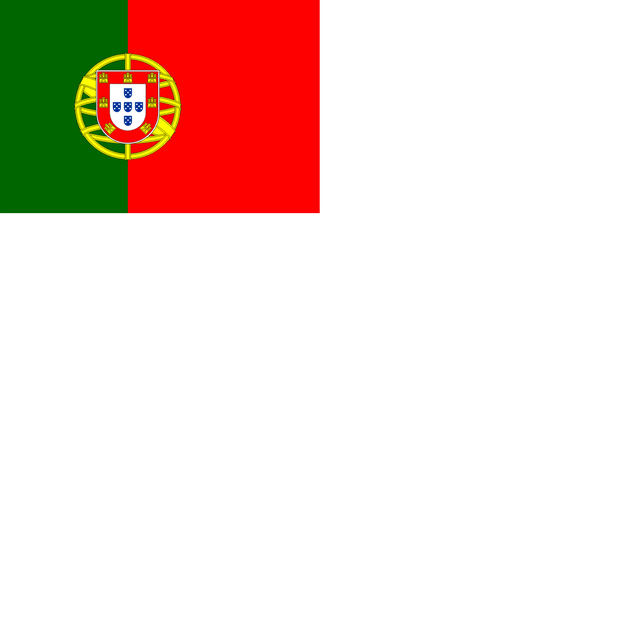
Portuguese people

| Total population | |
|---|---|
| c. 40 million[a][1][2][3][4][5] | |
| Regions with significant populations | |
| c.40 million(Recent Portuguese ancestry)[7][8] | |
| 1,720,000(Portuguese born & ancestry)[9][10] | |
| 1,471,549(Portuguese ancestry) | |
| 455,441(Only Portuguese ancestry: ~400,000)[11] (additional 55,441 Portuguese born)[12] | |
| 429,850(Portuguese ancestry)[13] | |
| 300,000 | |
| 300,000[14] | |
| 265,000[15][16] | |
| 170,000 | |
| 140,000[10] | |
| 126,651 [17] | |
| 103,900 | |
| 50,000(Portuguese ancestry) | |
| 46,519[18] | |
| 40,413[10] | |
| 40,100[19] | |
| 38,000 | |
| 24,242[20] | |
| 22,318[10] | |
| 10,764[21] | |
| 6.338[22] | |
| 4,000[23] | |
| 3,159[10] | |
| 2,523[10] | |
| 2,445[10] | |
| 1,969[10] | |
| 1,640[10] | |
| 1,574[24] | |
| 1,523[10] | |
| 1,055[10] | |
| 992 | |
| 942[25] | |
| 836 | |
| 800 - 1000 [26] | |
| 482[10] | |
| 792 | |
| 777 | |
| Rest of Europe | 30,822 |
| Rest of Asia | 30,000 + |
| Languages | |
| Portuguese, Mirandese | |
| Religion | |
| Mainly Christianity: Roman Catholicism[27] Sizable segments of agnostics and atheists | |
| Related ethnic groups | |
| Galicians, Spaniards, Romance peoples | |
^aTotal number of ethnic Portuguese varies wildly based on the definition. | |
Portuguese people are a Romance[28][29][30] ethnic group indigenous to Portugal that share a common Portuguese culture and speak Portuguese. Their predominant religion is Christianity, mainly Roman Catholicism, though vast segments of the population, especially the younger generations, have no religious affiliation. Historically, the Portuguese people's heritage largely includes the pre-Celts and Celts (Celtiberians, Lusitanians, Gallaecians, Oestriminis, Turduli and Celtici), who became culturally Romanized during the conquest of the region by the ancient Romans. A number of Portuguese also can trace descent from Germanic tribes who arrived after the Roman period as ruling elites, including the Suebi and Visigoths in northern Portugal and central Portugal. Finally, also limited converted Jewish and Berbers as a result of the Moorish occupation of the Iberian Peninsula, especially in the Algarve region of southern Portugal.[31]
The Roman Republic conquered the Iberian Peninsula during the 2nd and 1st centuries B.C. from the extensive maritime empire of Carthage during the series of Punic Wars. As a result of Roman colonization, the majority of Portuguese language stems from the Vulgar Latin. Due to the large historical extent from the 16th century of the Portuguese Empire and the subsequent colonization of territories in Asia, Africa and the Americas, as well as historical and recent emigration, Portuguese communities can be found in many diverse regions around the globe, and a large Portuguese diaspora exists.
Portuguese people began and led the Age of Exploration which started in 1415 with the conquest of Ceuta and culminated in an empire with territories that are now part of over 50 countries. The Portuguese Empire lasted nearly 600 years, seeing its end when Macau was returned to China in 1999. The discovery of several lands unknown to the Europeans in the Americas, Africa, Asia and Oceania (southwest Pacific Ocean), helped pave the way for modern globalization and domination of Western civilization.
| Total population | |
|---|---|
| c. 40 million[a][1][2][3][4][5] | |
| Regions with significant populations | |
| c.40 million(Recent Portuguese ancestry)[7][8] | |
| 1,720,000(Portuguese born & ancestry)[9][10] | |
| 1,471,549(Portuguese ancestry) | |
| 455,441(Only Portuguese ancestry: ~400,000)[11] (additional 55,441 Portuguese born)[12] | |
| 429,850(Portuguese ancestry)[13] | |
| 300,000 | |
| 300,000[14] | |
| 265,000[15][16] | |
| 170,000 | |
| 140,000[10] | |
| 126,651 [17] | |
| 103,900 | |
| 50,000(Portuguese ancestry) | |
| 46,519[18] | |
| 40,413[10] | |
| 40,100[19] | |
| 38,000 | |
| 24,242[20] | |
| 22,318[10] | |
| 10,764[21] | |
| 6.338[22] | |
| 4,000[23] | |
| 3,159[10] | |
| 2,523[10] | |
| 2,445[10] | |
| 1,969[10] | |
| 1,640[10] | |
| 1,574[24] | |
| 1,523[10] | |
| 1,055[10] | |
| 992 | |
| 942[25] | |
| 836 | |
| 800 - 1000 [26] | |
| 482[10] | |
| 792 | |
| 777 | |
| Rest of Europe | 30,822 |
| Rest of Asia | 30,000 + |
| Languages | |
| Portuguese, Mirandese | |
| Religion | |
| Mainly Christianity: Roman Catholicism[27] Sizable segments of agnostics and atheists | |
| Related ethnic groups | |
| Galicians, Spaniards, Romance peoples | |
^aTotal number of ethnic Portuguese varies wildly based on the definition. | |
Ancestry
Historical origins
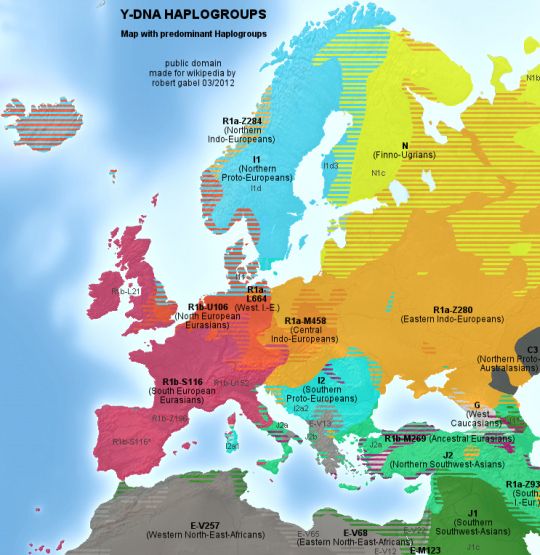
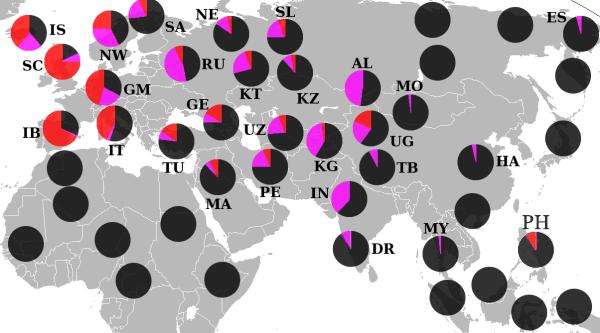
Distribution of R1a (purple) and R1b (red). See also this map for distribution in Europe.
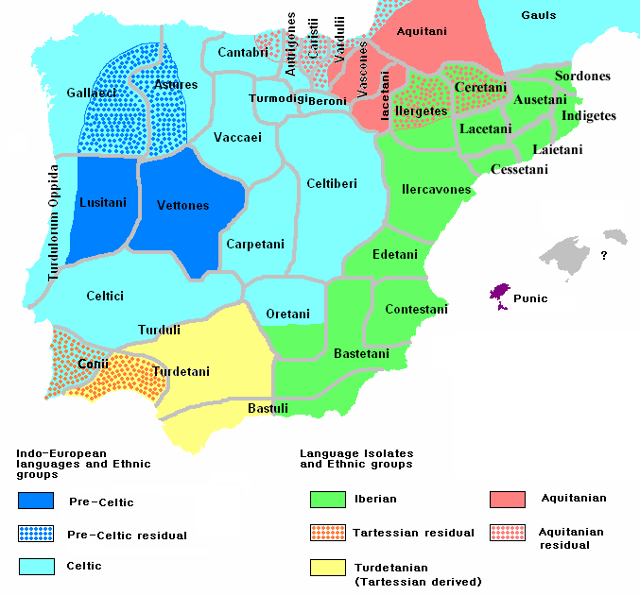
Ethnographic and Linguistic Map of the Iberian Peninsula at about 200 BC.[35]
The Portuguese are a Southwestern European population, with origins predominantly from Southern and Western Europe. The earliest modern humans inhabiting Portugal are believed to have been Paleolithic peoples that may have arrived in the Iberian Peninsula as early as 35,000 to 40,000 years ago. Current interpretation of Y-chromosome and mtDNA data suggests that modern-day Portuguese trace a significant amount of these lineages to the paleolithic peoples who began settling the European continent between the end of the last glaciation around 45,000 years ago.
Northern Iberia is believed to have been a major Ice-age refuge from which Paleolithic humans later colonized Europe. Migrations from what is now Northern Iberia during the Paleolithic and Mesolithic, links modern Iberians to the populations of much of Western Europe and particularly the British Isles and Atlantic Europe. Recent books published by geneticists Bryan Sykes, Stephen Oppenheimer and Spencer Wells have emphasized the large Paleolithic and Mesolithic Iberian influence in the modern day Irish, Welsh and Scottish gene-pool as well as parts of the English. Indeed, Y-chromosome haplogroup R1b (of Paleolithic origin) is the most common haplogroup in practically all of the Iberian peninsula and western Europe.[32] Within the R1b haplogroup there are modal haplotypes. One of the best-characterized of these haplotypes is the Atlantic Modal Haplotype (AMH). This haplotype reaches the highest frequencies in the Iberian Peninsula and in the British Isles. In Portugal it reckons generally 65% in the South summing 87% northwards, and in some regions 96%.[33]
The Neolithic colonization of Europe from Western Asia and the Middle East beginning around 10,000 years ago reached Iberia, as most of the rest of the continent although, according to the demic diffusion model, its impact was most in the southern and eastern regions of the European continent.[34]
Starting in the 3rd millennium BC as well as in the Bronze Age, the first wave of migrations into Iberia of speakers of Indo-European languages occurred. These were later (7th and 5th Centuries BC) followed by others that can be identified as Celts.
Urban cultures eventually developed in southeastern Iberia, such as Tartessos, influenced by the Phoenician colonization of coastal Mediterranean Iberia, which later shifted to Greek colonization. There is very little or no evidence of settlements in Portugal by either Greeks or Phoenicians despite some statements to the contrary.
These two processes defined Iberia's, and Portugal's, cultural landscape—Continental in the northwest and Mediterranean towards the southeast, as historian José Mattoso describes it.[36] Given the origins from Paleolithic and Neolithic settlers as well as Indo-European migrations, one can say that the Portuguese ethnic origin is mainly a mixture of pre-Roman, pre-Indo-Europeans (such as, in other parts of Iberia, the Iberians, Aquitanians), and pre-Celtics or para-Celts such as the Lusitanians of Lusitania, and Celtic peoples such as Calaicians or Gallaeci of Gallaecia, the Celtici and the Cynetes of the Alentejo and the Algarve.
The Romans were also an important influence on Portuguese culture; the Portuguese language derives mostly from Latin.
Other minor influences included the Phoenicians/Carthaginians (small semi-permanent commercial coastal establishments in the south before 200 BC), the Vandals (Silingi and Hasdingi) and the Sarmatian Alans (both migrated to North Africa, while some were partially integrated by the Visigoths and Suebi), and the Visigoths and Suebi (including the Buri, permanently established in the early 5th century). The Moors ruled from 711 until the Reconquista of the Algarve in 1249. In the 9th and 10th centuries small Viking[37] raids and settlements also occurred in the North coastal regions of Douro and Minho.[38][39]
Portuguese have also maintained a certain degree of ethnic and cultural specific characteristics-ratio with the Basques, since ancient times. The results of the present HLA study in Portuguese populations show that they have features in common with Basques and some Spaniards from Madrid: a high frequency of the HLA-haplotypes A29-B44-DR7 (ancient western Europeans) and A1-B8-DR3 are found as common characteristics. Many Portuguese, and Basques do not show the Mediterranean A33-B14-DR1 haplotype, confirming a lower admixture with Mediterraneans. The Portuguese have a characteristic unique among world populations: a high frequency of HLA-A25-B18-DR15 and A26-B38-DR13, which may reflect a still detectable founder effect coming from ancient Portuguese, i.e., Oestriminis and Cynetes.[40]
Lusitanians
The Lusitanians (or Lusitānus/Lusitani in Latin) were an Indo-European speaking people (likely Celtic) living in the Western Iberian Peninsula long before it became the Roman province of Lusitania (modern Portugal, Extremadura and a small part of Salamanca). They spoke the Lusitanian language, of which only a few short written fragments survive. Most Portuguese consider the Lusitanians as their ancestors. Although the northern regions (Minho, Douro, Tras-os-Montes) identify more with the Gallaecians.
It has been hypothesized that the Lusitanians may have originated in the Alps and settled in the region in the 6th century BC. Some modern scholars consider them to be indigenous and initially dominated by the Celts, before gaining full independence from them. The archaeologist Scarlat Lambrino proposed that they were originally a tribal Celtic group, related to the Lusones.
The first area settled by the Lusitanians was probably the Douro valley and the region of Beira Alta; then they moved south, and expanded on both sides of the Tagus river, before being conquered by the Romans.
The original Roman province of Lusitania was extended north of the areas occupied by the Lusitanians to include the territories of Asturias and Gallaecia but these were soon ceded to the jurisdiction of the Provincia Tarraconensis in the north, while the south remained the Provincia Lusitania et Vettones. After this, Lusitania's northern border was along the Douro river, while its eastern border passed through Salmantica and Caesarobriga to the Anas (Guadiana) river.
Pre-Roman groups
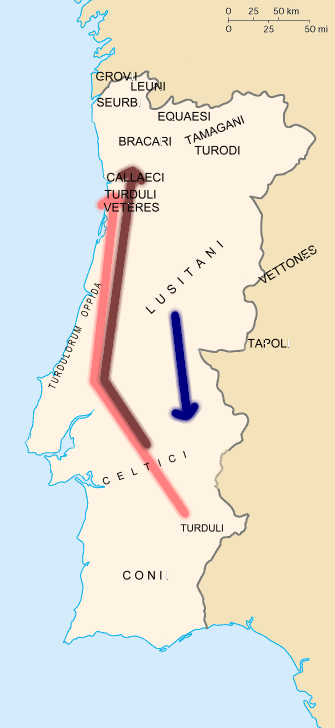
Map showing the main pre-Roman tribes in Portugal and their main migrations. Turduli movement in red, Celtici in brown and Lusitanian in a blue colour. Most tribes neighbouring the Lusitanians were dependent on them. Names are in Latin.
The Lusitanians were a single large tribe that lived between the rivers Douro and Tagus. As the Lusitanians fought fiercely against the Romans for independence, the name Lusitania was adopted by the Gallaeci, tribes living north of the Douro, and other closely surrounding tribes, eventually spreading as a label to all the nearby peoples fighting Roman rule in the west of Iberia. It was for this reason that the Romans came to name their original province in the area, that initially covered the entire western side of the Iberian peninsula, Lusitania.
Tribes, often known by their Latin names, living in the area of modern Portugal, prior to Roman rule:
Bardili (Turduli) – living in the Setúbal peninsula;
Bracari – living between the rivers Tâmega and Cávado, in the area of the modern city of Braga;
Callaici – living along and north of the Douro;
Celtici – Celts living in Alentejo;
Coelerni – living in the mountains between the rivers Tua and Sabor;
Cynetes or Conii – living in the Algarve and the south of Alentejo;
Equaesi – living in the most mountainous region of modern Portugal;
Grovii – a mysterious tribe living in the Minho valley;
Interamici – living in Trás-os-Montes and in the border areas with Galicia and León (in modern Spain);
Leuni – living between the rivers Lima and Minho;
Luanqui – living between the rivers Tâmega and Tua;
Lusitani – being the most numerous and dominant of the whole region comprising most of Portugal;
Limici – living in the swamps of the river Lima, on the border between Portugal and Galicia);
Narbasi – living in the north of modern Portugal (interior) and nearby area of southern Galicia;
Nemetati – living north of the Douro Valley in the area of Mondim;
Paesuri – a dependent tribe of the Lusitanians, living between the rivers Douro and Vouga;
Quaquerni – living in the mountains at the mouths of rivers Cávado and Tâmega;
Seurbi – living between the rivers Cávado and Lima (or even reaching the river Minho);
Tamagani – from the area of Chaves, near the river Tâmega;
Tapoli – another dependent tribe of the Lusitanians, living north of the river Tagus, on the border between modern Portugal and Spain;
Turduli – in the east of Alentejo (Guadiana Valley);
Turduli Veteres – the "ancient Turduli" living south of the estuary of the river Douro;
Turdulorum Oppida – Turduli living in the Portuguese region of Estremadura;
Turodi – living in Trás-os-Montes and bordering areas of Galicia;
Vettones – living in the eastern border areas of Portugal, and in Spanish provinces of Ávila and Salamanca, as well as parts of Zamora, Toledo and Cáceres;
Zoelae – living in the mountains of Serra da Nogueira, Sanabria and Culebra, up to the mountains of Mogadouro in northern Portugal and adjacent areas of Galicia.
Romanization
Since 193 B.C., the Lusitanians had been fighting Rome and its expansion into the peninsula following the defeat and occupation of Carthage in North Africa. They defended themselves bravely for years, causing the Roman invaders serious defeats. In 150 B.C., they were defeated by Praetor Servius Galba: springing a clever trap, he killed 9,000 Lusitanians and later sold 20,000 more as slaves further northeast in the newly conquered Roman provinces in Gaul (modern France) by Julius Caesar. Three years later (147 B.C.), Viriathus became the leader of the Lusitanians and severely damaged the Roman rule in Lusitania and beyond. In 139 B.C. Viriathus was betrayed and killed in his sleep by his companions (who had been sent as emissaries to the Romans), Audax, Ditalcus and Minurus, bribed by Marcus Popillius Laenas. However, when Audax, Ditalcus and Minurus returned to receive their reward by the Romans, the Consul Servilius Caepio ordered their execution, declaring, "Rome does not pay traitors".
After Viriathus' rule, the Lusitanians became largely romanized, adopting Roman culture and the language of Latin. The Lusitanian cities, in a manner similar to those of the rest of the Roman-Iberian peninsula, eventually gained the status of "Citizens of Rome". The Portuguese language itself is a local later evolution of the Roman language, Latin after the fall of the Western Roman Empire in the 5th and 6th centuries.
General traits
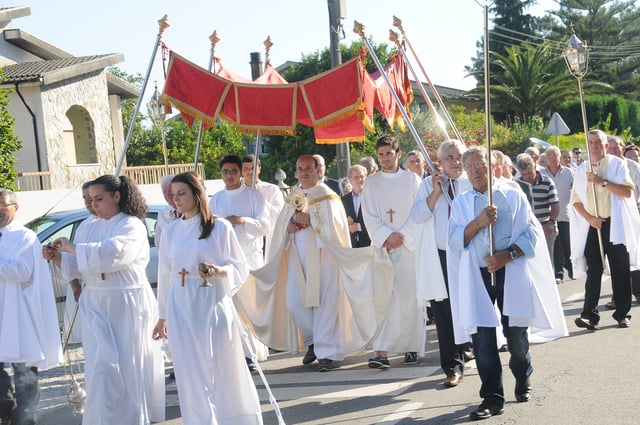
Procession in Amares e Figueiredo, Portugal
Modern Portuguese are an Iberian ethnic group and share a similar makeup to that of the fellow Southern Europeans.[41] The Western Coast of Iberia, which composes the land of Galicia and Portugal, was a converging point of migratory movements in the past and during the Portuguese Discoveries. As a result, the Portuguese were introduced to new cultures and ethnicities. With the end of the Indigenous Statute in the early 1960s,[42] indigenous people of Portuguese colonies were granted Portuguese citizenship as the end of Portuguese colonialism was marked with the hand over of Macau to the People's Republic of China in 1999, after 500 years of Portuguese administration. Regarding this, it is comprehensible that any relationship between citizenship and anthropometrical features can be questioned, nevertheless, it is possible to draw the general anthropometrical features of the majority of the Portuguese population. Dark to medium brown hair and brown and hazel eyes are predominant. However, light brown and blond hair and blue and green eyes are also found frequently. Chestnut and auburn-colored hair types occur generally. Legitimate black hair—not espresso brown—can be found, but it is not very common. Light, true red hair (meaning red shades that are non-auburn) is seen on occasion.
A recent study by Candille et al. (2012) comparing pigmentation levels between the Portuguese and three other ethnically indigenous European national groups—the Irish, the Polish and the Italians—concluded that, in parts of the body not exposed to the sun, the Irish were in the lightest end of the spectrum, followed by the Portuguese, Poles and Italians, with the latter being darkest. In terms of hair color, the Portuguese averaged lighter hair than Italians and darker than Irish and Poles. The Portuguese exhibited significantly lower frequencies in lighter eye shades in comparison to the Irish and Polish, and marginally less, compared to Italians.[43]
Demography
Demographics of Portugal
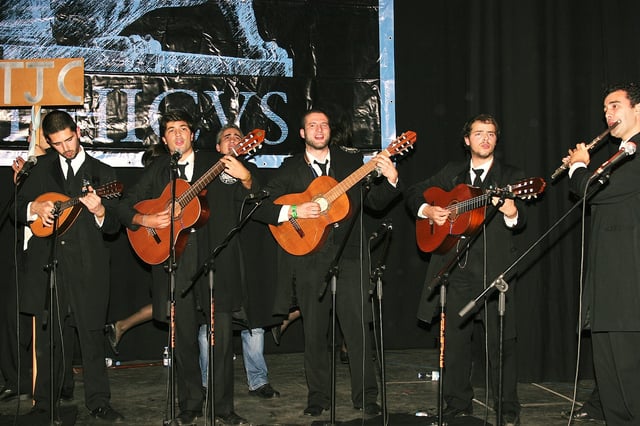
Portuguese men playing Fado

Portuguese women in traditional costumes, from Viana do Castelo
There are around 10 million native Portuguese in Portugal, out of a total population of 10.34 million (estimate).
Native minority languages in Portugal
A small minority of about 15,000 speak the Mirandese language, (part of the Asturian-Leonese linguistic group which includes the Asturian and Leonese minority languages of Northwestern Spain [44][45][46][47]) in the municipalities of Miranda do Douro, Vimioso and Mogadouro. All of the speakers are bilingual with Portuguese.
An even smaller minority of no more than 2,000 people speak Barranquenho, a dialect of Portuguese heavily influenced by Extremaduran, spoken in the Portuguese town of Barrancos (in the border between Extremadura and Andalusia, in Spain, and Portugal).
Ethnic minorities in Portugal
Some people from the former colonies, namely Brazil, Portuguese Africa, Macau (China), Portuguese India and East Timor, have been migrating to Portugal since the 1900s.
More recently, a great number of Slavs, especially Ukrainians (now the third biggest ethnic minority[48]) and Russians, as well as Moldovans and Romanians, keep migrating to Portugal. There is also a Chinese minority, which are mainly of Macau Cantonese origin.
Portuguese diaspora
Overview

Cape Verdian President Jorge Carlos Fonseca
In the whole world there are easily more than one hundred million people with recognizable Portuguese ancestors, due to the colonial expansion and worldwide immigration of Portuguese from the 16th century onwards to India, the Americas, Macau (see Macanese people), East-Timor, Malaysia, Indonesia and Africa. Between 1886 and 1966, Portugal lost to emigration more than any West European country except Ireland.[51] From the middle of the 19th century to the late 1950s, nearly two million Portuguese left Europe to live mainly in Brazil and with significant numbers to the United States.[52] About 40 million Brazilians have relatively recent Portuguese background, due to massive immigration in the late 19th and early 20th centuries. About 1.2 million Brazilian citizens are native Portuguese.[53] Significant verified Portuguese minorities exist in several countries (see table).[54] In 1989 some 4,000,000 Portuguese were living abroad, mainly in France, Germany, Brazil, the United Kingdom, South Africa, Canada, Venezuela, the United States, the United Arab Emirates.[55] Within Europe, substantial concentrations of Portuguese may be found in Francophone countries like France, Luxembourg and Switzerland, spurred in part by their linguistic proximity with the French language.
Portuguese Sephardi Jews
Portuguese Sephardi Jews (mostly descendants) are also in Israel, the Netherlands, the United States, France, Venezuela, Brazil[56] and Turkey. In Brazil many of the colonists were also originally Sephardi Jews, who, converted, were known as New Christians.
The Americas outside of Brazil and the Pacific
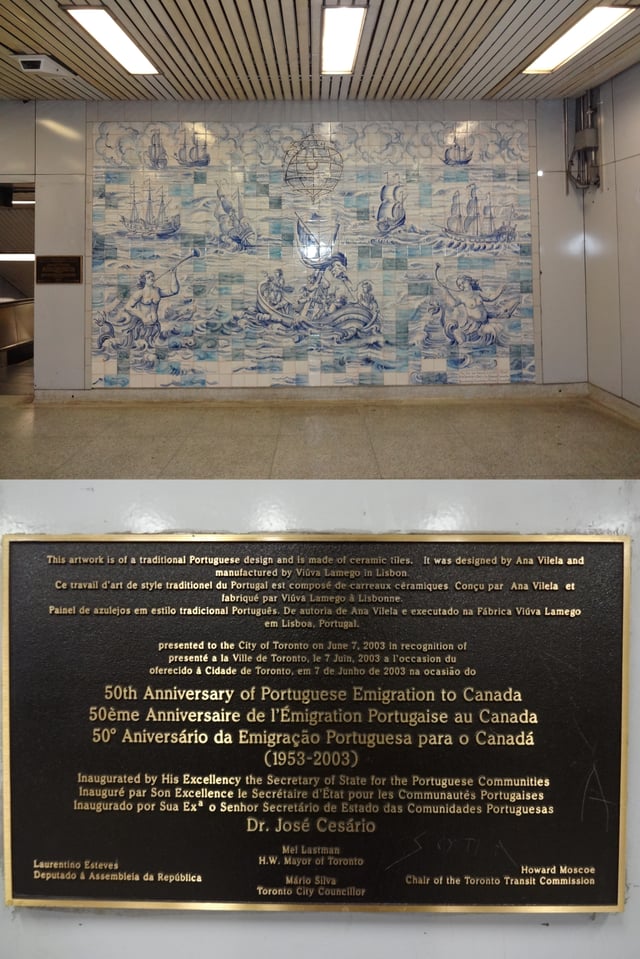
Explorer João Álvares Fagundes commemorative monument surrounded by Portuguese pavement, in Halifax (up) and Azulejos, sign and frame about Portuguese immigration inside a subway station in Toronto (down) , both in Canada
In the United States, there are Portuguese communities in New Jersey, the New England states, and California. Springfield, Illinois once possessed the largest Portuguese Community in the Midwest.[57] In the Pacific, Hawaii has a sizable Portuguese element that goes back 150 years (see Portuguese Americans), Australia and New Zealand also have Portuguese communities (see Portuguese Australians, Portuguese New Zealanders). Canada, particularly Ontario, Quebec and British Columbia, has developed a significant Portuguese community since 1940 (see Portuguese Canadians). Argentina (See Portuguese Argentine and Cape Verdean Argentine) and Uruguay (see Portuguese Uruguayan) had Portuguese immigration in the early 20th century. Portuguese fishermen, farmers and laborers dispersed across the Caribbean, especially Bermuda (3.75%[58] to 10%[59] of the population), Guyana (4.3% of the population in 1891),[60] Trinidad,[61] St. Vincent and the Grenadines, and the island of Barbados where there is high influence from the Portuguese community.[62]
Africa
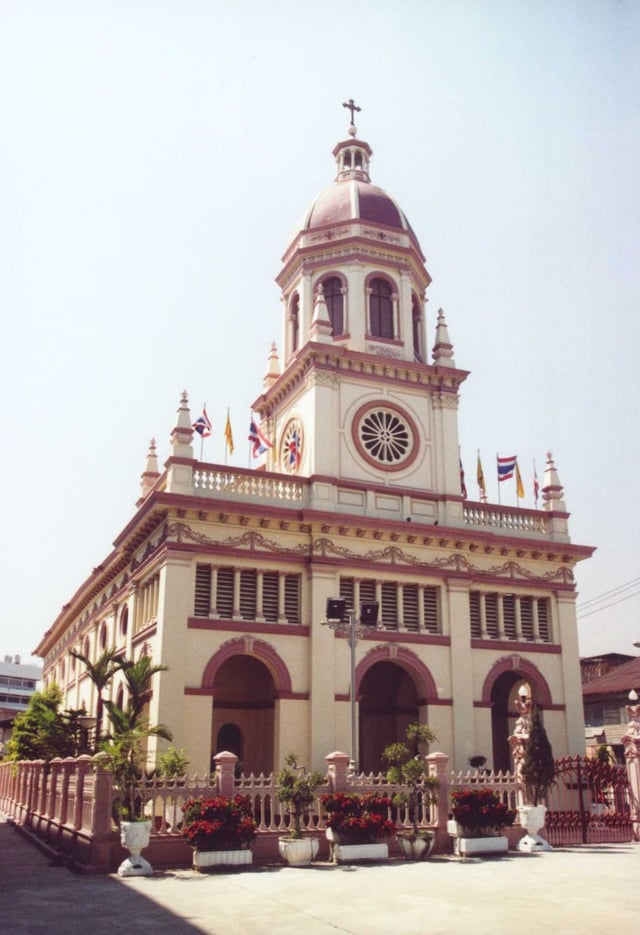
Santa Cruz Church, Thon Buri District, Bangkok, Constructed by Portuguese monks in the 18th Century.
In the early twentieth century the Portuguese government encouraged white emigration to Angola and Mozambique, and by the 1970s, there were up to 1 million Portuguese settlers living in their overseas African provinces.[63] An estimated 800,000 Portuguese returned to Portugal as the country's African possessions gained independence in 1975, after the Carnation Revolution, while others moved to South Africa, Botswana and Algeria.[64][65][66]
In Europe outside of Portugal
Portuguese constitute 13% of the population of Luxembourg. In 2006 there were estimates to be around half a million people of Portuguese origin in the United Kingdom (see Portuguese in the United Kingdom)—this is considerably larger than around the 88,000 Portuguese-born people alone residing in the country in 2009 (estimation; however this figure does not include British-born people of Portuguese descent). In areas such as Thetford and the crown dependencies of Jersey and Guernsey, the Portuguese form the largest ethnic minority groups at 30% of the population, 7% and 3% respectively. The British capital London is home to the largest number of Portuguese people in the UK, with the majority being found in the boroughs of Kensington and Chelsea, Lambeth and Westminster.[67] The Portuguese diaspora communities still are very attached to their language, their culture and their national dishes and particularly the bacalhau.[68]
Portuguese Diaspora in the rest of the world
There are Portuguese influenced people with their own culture and Portuguese based dialects in parts of the world other than former Portuguese colonies, notably in Barbados, Jamaica, Aruba, Curaçao, St. Vincent and the Grenadines, Trinidad and Tobago, Guyana (see Portuguese immigrants in Guyana), Equatorial Guinea and throughout Asia (Main Article Luso-Asians).
List of countries by population of Portuguese heritage
| Country | Population | % of country | Criterion |
|---|---|---|---|
| Portuguese in North America | |||
| 1,477,335 | 0.5% | [74] | |
| 429,850 | 1.3% | Canada 2011 Census[75] | |
| Portuguese in South America | |||
| 40,100 | 0.9% | [19] | |
| 5,000,000 (children and grandchildren, eligible for Portuguese citizenship) | 2,5% (children and grandchildren, eligible for Portuguese citizenship) | [76] | |
| 55,441 | 3.8% | [77] | |
| Portuguese in Europe | |||
| 1,720,000 | 2.5% | [78] | |
| 268,012 | 1.2% | [79] | |
| 88,161 | 0.08% | [67] | |
| 20,981 | 0.11% | [80][80] | |
| 82,300 | 16.1% | They constitute 16.1% of the population of Luxembourg, which makes them one of the largest ethnic groups as a proportion of the total national population. [81] | |
| Portuguese in Asia (See Luso-Asian) | |||
| 200,000 | 0.02% | ||
| 25,000 - 46,000 | 2% | [82] | |
| 5,000 | 0.02% | [83] | |
| ~ 3,000+ | 0.02% | [69][72][70] | |
| 1,400 - 2,000 | 0.02% | [72] | |
| 37,000 | [84] | ||
| Portuguese in Oceania | |||
| 56,000 | 0.4% | [85] | |
| 650 | 0.02% | [86] | |
| Portuguese in Africa | |||
| 500,000 | 1% | [14] | |
| 200,000 | 0.36% | [10] | |
| 126,476 | 0.15% | [10] | |
| Total in Diaspora | ~70,000,000 | ||
| 11,000,000 | [6] Figure is only a population estimate of all residents of Portugal, and includes people of non-Portuguese ethnic origin | ||
| Total Worldwide | unknown |
Portuguese ancestry in the Brazilian population

Passport of an immigrant from the Braga District to Brazil
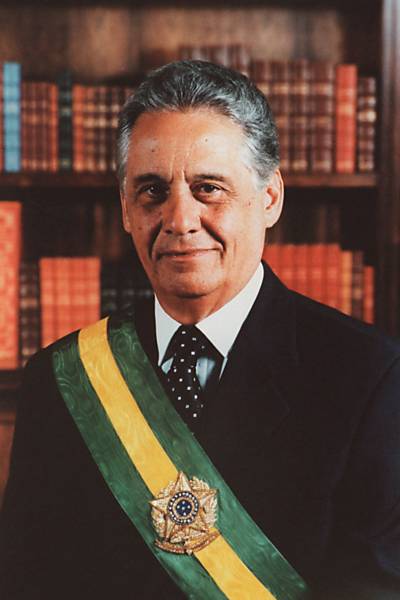
Former Brazilian President Fernando Henrique Cardoso descends from Portuguese immigrants
| Source: Brazilian Institute for Geography and Statistics (IBGE) | |||||||||||||||
| Decade | |||||||||||||||
|---|---|---|---|---|---|---|---|---|---|---|---|---|---|---|---|
| Nationality | 1500-1700 | 1701-1760 | 1808-1817 | 1827-1829 | 1837-1841 | 1856-1857 | 1881-1900 | 1901-1930 | 1931-1950 | 1951-1960 | 1961-1967 | 1981-1991 | 1991– 2017 | ||
| Portuguese | 100,000 | 600,000 | 24,000 | 2,004 | 629 | 16,108 | 316,204 | 754,147 | 148,699 | 235,635 | 54,767 | 4,605 | 400,000 | ||
In colonial times, over 700,000 Portuguese settled in Brazil, and most of them went there during the gold rush of the 18th century.[87] Brazil received more European settlers during its colonial era than any other country in the Americas. Between 1500 and 1760, about 700,000 Europeans immigrated to Brazil, compared to 530,000 European immigrants in the United States.[88][89] They managed to be the only significant European population to populate the country during colonization, even though there were French and Dutch invasions. The Portuguese migration was strongly marked by the predominance of men (colonial reports from the 16th and 17th centuries almost always report the absence or rarity of Portuguese women). This lack of women worried the Jesuits, who asked the Portuguese King to send any kind of Portuguese women to Brazil, even the socially undesirable (e.g. prostitutes or women with mental maladies such as Down Syndrome) if necessary.[90][91] The Crown responded by sending groups of Iberian orphan maidens to marry both cohorts of marriageable men, the nobles and the peasants. Some of which were even primarily studying to be nuns.[90][92] The Crown also shipped over many Órfãs d'El-Rei of what was considered "good birth" to colonial Brazil to marry Portuguese settlers of high rank. Órfãs d'El-Rei (modern Portuguese órfãs do rei) literally translates to "Orphans of the King", and they were Portuguese female orphans in nubile age.[93] There were noble and non-noble maidens and they were daughters of military compatriots who died in battle for the king or noblemen who died overseas and whose upbringing was paid by the Crown.[93] Bahia's port in the East received one of the first groups of orphans in 1551.[94] The multiplication of descendants of Portuguese settlers also happened to a large degree through miscegenation with black and amerindian women. In fact, in colonial Brazil the Portuguese men competed for the women, because among the African slaves the female component was also a small minority.[95] This explains why the Portuguese men left more descendants in Brazil than the Amerindian or African men did. The Indian and African women were "dominated" by the Portuguese men, preventing men of color to find partners with whom they could have children. Added to this, White people had a much better quality of life and therefore a lower mortality rate than the black and indigenous population. Then, even though the Portuguese migration during colonial Brazil was smaller (3.2 million Indians estimated at the beginning of colonization and 3.6 million Africans brought since then, compared to the descendants of the over 700,000 Portuguese immigrants) the "white" population (whose ancestry was predominantly Portuguese) was as large as the "non white" population in the early 19th century, just before independence from Portugal.[95] After independence from Portugal in 1822, around 1.7 million Portuguese immigrants settled in Brazil.[95] Portuguese immigration into Brazil in the 19th and 20th centuries was marked by its concentration in the states of São Paulo and Rio de Janeiro. The immigrants opted mostly for urban centers. Portuguese women appeared with some regularity among immigrants, with percentage variation in different decades and regions of the country. However, even among the more recent influx of Portuguese immigrants at the turn of the 20th century, there were 319 men to each 100 women among them.[96] The Portuguese were different from other immigrants in Brazil, like the Germans,[97] or Italians[98] who brought many women along with them (even though the proportion of men was higher in any immigrant community). Despite the small female proportion, Portuguese men married mainly Portuguese women. Female immigrants rarely married Brazilian men. In this context, the Portuguese had a rate of endogamy which was higher than any other European immigrant community, and behind only the Japanese among all immigrants.[99]
Even with Portuguese heritage, many Portuguese-Brazilians identify themselves as being simply Brazilians, since Portuguese culture was a dominant cultural influence in the formation of Brazil (like many British Americans in the United States, who will never describe themselves as of British extraction, but only as "Americans", since British culture was a dominant cultural influence in the formation of The United States).
In 1872, there were 3.7 million Whites in Brazil (the vast majority of them of Portuguese ancestry), 4.1 million mixed-race people (mostly of Portuguese-African-Amerindian ancestry) and 1.9 million Blacks. These numbers give the percentage of 80% of people with total or partial Portuguese ancestry in Brazil in the 1870s.[100]
In the late 19th and early 20th centuries, a new large wave of immigrants from Portugal arrived. From 1881 to 1991, over 1.5 million Portuguese immigrated to Brazil. In 1906, for example, there were 133,393 Portuguese-born people living in Rio de Janeiro, comprising 16% of the city's population. Rio is, still today, considered the largest "Portuguese city" outside of Portugal itself, with 1% Portuguese-born people.[88][101]
Genetic studies also confirm the strong Portuguese genetic influence in Brazilians. According to a study, at least half of the Brazilian population's Y Chromosome (male inheritance) comes from Portugal. Black Brazilians have an average of 48% non-African genes, most of them may come from Portuguese ancestors. On the other hand, 33% Amerindian and 28% African contribution to the total mtDNA (female inheritance) of white Brazilians was found[3][4]
An autosomal study from 2013, with nearly 1300 samples from all of the Brazilian regions, found a predominant degree of European ancestry (mostly Portuguese, due to the dominant Portuguese influx among European colonization and immigration to Brazil) combined with African and Native American contributions, in varying degrees. 'Following an increasing North to South gradient, European ancestry was the most prevalent in all urban populations (with values from 51% to 74%). The populations in the North consisted of a significant proportion of Native American ancestry that was about two times higher than the African contribution. Conversely, in the Northeast, Center-West and Southeast, African ancestry was the second most prevalent. At an intrapopulation level, all urban populations were highly admixed, and most of the variation in ancestry proportions was observed between individuals within each population rather than among population'.[102]
A large community-based multicenter autosomal study from 2015, considering representative samples from three different urban communities located in the Northeast (Salvador, capital of Bahia), Southeast (Bambuí, interior of Minas Gerais) and South Brazilian (Pelotas, interior of Rio Grande do Sul) regions, estimated European ancestry to be 42.4%, 83.8% and 85.3%, respectively.[103] In all three cities, European ancestors were mainly Iberian.
It was estimated that around 5 million Brazilians (2,5% of the population) can acquire Portuguese citizenship, due to the last Portuguese nationality law that grants citizenship to grandchildren of Portuguese nationals.[104]
Genetics

According to an early genetic study, the Portuguese are a relatively distinct population according to HLA data, as they have a high frequency of the HLA-A25-B18-DR15 and A26-B38-DR13 genes. The latter is a unique Portuguese marker — the Portuguese have neither a significant contribution to their genetic pool from paleo-North Africans (A30-B18) nor Mediterraneans (A33-B14). As such, they may have remained in relative genetic isolation compared to the rest of the Iberian populations. In Europe, the A25-B18-DR15 gene is only found in Portugal, and is also observed in white North Americans and in Brazilians (very likely of Portuguese ancestry).[105]
R1b-5 gene cluster is a male re-expansion 15,000-13,000 years ago from Northwestern Iberia heading towards Ireland, Wales and Northern Scotland. The Rory gene cluster (R1b-14) is one of the largest re-expansions also head towards Ireland and Scotland, however featuring particularly in Irish men with Gaelic names.[106]
See also
European ethnic groups
Eurasians in Singapore
List of Portuguese people
Portuguese Indonesian
